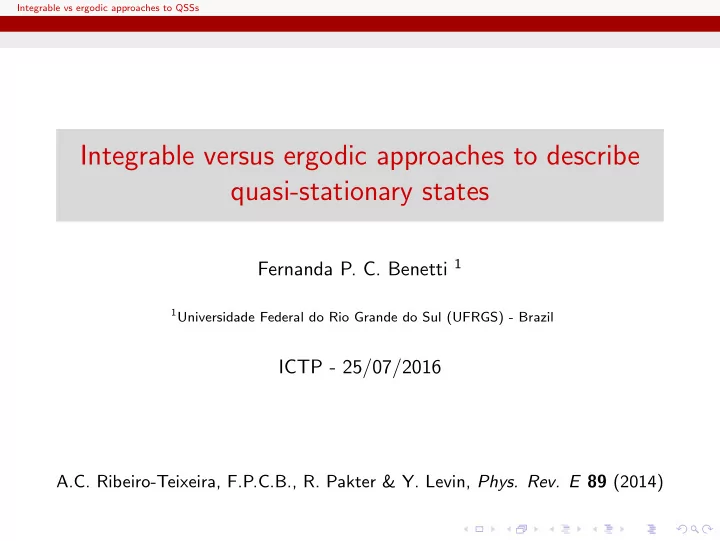

Integrable vs ergodic approaches to QSSs Integrable versus ergodic approaches to describe quasi-stationary states Fernanda P. C. Benetti 1 1 Universidade Federal do Rio Grande do Sul (UFRGS) - Brazil ICTP - 25/07/2016 A.C. Ribeiro-Teixeira, F.P.C.B., R. Pakter & Y. Levin, Phys. Rev. E 89 (2014)
Integrable vs ergodic approaches to QSSs The HMF model Konishi & Kaneko (1992), Antoni & Ruffo (1995) ◮ N spins ◮ Hamiltonian N N N p 2 2 + 1 � � � i H = [1 − cos( θ i − θ j )] 2 N i =1 i =1 j =1 ◮ Equation of motion ˙ θ i = p i p i = − M sin θ i ˙ N M = 1 � cos θ i N i =1 ◮ Thermodynamic limit N → ∞ : Vlasov (collisionless) dynamics
Integrable vs ergodic approaches to QSSs Quasi-stationary states Two phases: ◮ paramagnetic ( M = 0) ◮ ferromagnetic ( M > 0)
Integrable vs ergodic approaches to QSSs Virial and non-virial initial conditions Virial theorem: � N � � − F ( q i ) · q i = 2 �K� i =1 K = kinetic energy ◮ Ex: 3D gravity → 2 K = −U .
Integrable vs ergodic approaches to QSSs Virial and non-virial initial conditions Virial theorem: � N � � − F ( q i ) · q i = 2 �K� i =1 K = kinetic energy ◮ Ex: 3D gravity → 2 K = −U . Initial conditions do not satisfy virial theorem ◮ Strong mean-field oscillations ◮ Resonances, core-halo distribution (Friday’s talk by Y. Levin)
Integrable vs ergodic approaches to QSSs Virial and non-virial initial conditions Virial theorem: � N � � − F ( q i ) · q i = 2 �K� i =1 K = kinetic energy ◮ Ex: 3D gravity → 2 K = −U . Initial conditions do not satisfy virial theorem ◮ Strong mean-field oscillations ◮ Resonances, core-halo distribution (Friday’s talk by Y. Levin) Initial conditions satisfy virial theorem ◮ Minimal mean-field oscillations ◮ Quasi-stationary potential
Integrable vs ergodic approaches to QSSs Lynden-Bell statistics Initial distribution: f 0 ( r , v ) = η Θ( r m − | r | )Θ( v m − | v | ) Number of microstates W : ◮ Phase space → macrocells and microcells ◮ Incompressible dynamics: number of occupied microcells is preserved ◮ Boltzmann counting
Integrable vs ergodic approaches to QSSs Lynden-Bell (LB) Statistics Coarse-grained entropy: s LB = k B ln W Coarse-grained distribution: η f LB ( r , v ) = 1 + exp [ β ( ǫ ( r , v ) − µ )]
Integrable vs ergodic approaches to QSSs Lynden-Bell (LB) Statistics Assumption: ◮ Equal probability of phase elements occupying any microcell → ergodicity and mixing
Integrable vs ergodic approaches to QSSs Virial and non-virial initial conditions Virial theorem: � N � � − F ( q i ) · q i = 2 �K� , K = kinetic energy i =1 ◮ Ex: 3D gravity → 2 K = −U . Initial conditions do not satisfy virial theorem ◮ Strong mean-field oscillations ◮ Resonances, core-halo distribution (Friday’s talk by Y. Levin) Initial conditions satisfy virial theorem ◮ Minimal mean-field oscillations ◮ Quasi-stationary potential ? ◮ Lynden-Bell statistics
Integrable vs ergodic approaches to QSSs Uncoupled pendula approach The model – de Buyl et al, PRE 84 (2011): QSS: ◮ External field H ◮ Uncoupled particles, equation of ◮ Quasi-static field motion ¨ θ = − H sin θ M = � cos θ � ◮ f ( ε ) = n ( ε ) / g ( ε ) is conserved ◮ Equation of motion ¨ θ = − M sin θ ◮ Integrable dynamics → “integrable model” (IM)
Integrable vs ergodic approaches to QSSs A.C. Ribeiro-Teixeira et al, PRE 89 (2014) � f 0 ( θ, p ) δ [ ε − ǫ ( θ, p , H )] d θ dp f ( ε ; H ) = � δ [ ε − ǫ ( θ, p , H )] d θ dp � P ( θ ; H ) = f [ ε ( θ, p ); H ] dp � Association with HMF: H = cos θ P ( θ ; H ) d θ
Integrable vs ergodic approaches to QSSs Application to the HMF ◮ Initial conditions: f 0 ( θ, p ) = Θ( θ m − | θ | ) L � × η i Θ( | p | − p i − 1 )Θ( p i − | p | ) i =1 ◮ Analytical equation for f ( ε )
Integrable vs ergodic approaches to QSSs Comparison with molecular dynamics (MD) and Lynden-Bell (LB) Angle and momentum distributions L = 1
Integrable vs ergodic approaches to QSSs Comparison MD, IM, LB Angle and momentum distributions L = 3
Integrable vs ergodic approaches to QSSs Comparison MD, IM, LB Energy distribution ◮ L = 1 ◮ L = 2
Integrable vs ergodic approaches to QSSs Comparison MD, IM, LB RMS deviation of energy distributions (triangles: IM-MD deviation, circles: LB-MD deviation)
Integrable vs ergodic approaches to QSSs Summary ◮ IM: Uncoupled particles subject to external field H = M ◮ LB: Ergodic, mixing approach; new statistical method ◮ H = M , M → virial magnetization ◮ IM (integrable) better results than LB (ergodic) for MD with initial multilevel waterbag distributions ◮ Agreement decreases when number of levels increases ◮ IM can be used for other long-range systems, i.e. 3d self-gravitating systems (FPCB, A.C Ribeiro-Teixeira, R. Pakter & Y. Levin, PRL 113 2014)
Integrable vs ergodic approaches to QSSs Comparison with molecular dynamics (MD) Phase space
Recommend
More recommend